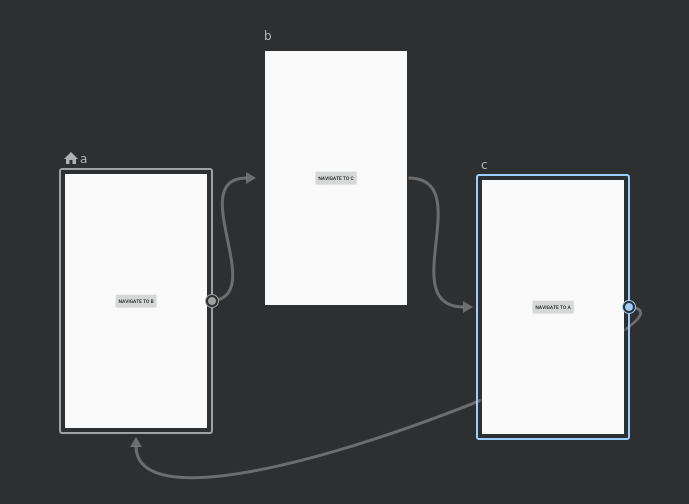デスティネーションにポップバックする必要がある例としてわかりやすいのは、ナビゲーションが循環型の場合です。このドキュメントでは、そのようなユースケースの概要を示します。
シナリオ
アプリに A、B、C の 3 つのデスティネーションがあるとします。また、A から B、B から C、C から A に移動するアクションもあります。対応するナビゲーション グラフは次のようになります。

NavController は、ナビゲーション アクションごとに新しいデスティネーションをバックスタックに追加します。そのため、図のフローで移動を繰り返すと、バックスタックに各デスティネーションの複数のセット(A、B、C、A、B、C、A、B、C)が含まれることになります。
解決策
バックスタックでの繰り返しを回避するには、NavController.navigate() の呼び出しまたはナビゲーション アクションで、popUpTo() と inclusive を指定します。
デスティネーション C に到達した後、バックスタックに各デスティネーション(A、B、C)のインスタンスが 1 つ含まれているとします。ユーザーをデスティネーション C からデスティネーション A に移動させるアクションまたは navigate() の呼び出しで、popUpTo() と inclusive を指定するようにします。
この場合、ユーザーがデスティネーション C からデスティネーション A に戻ると、NavController も A にポップアップされます。つまり、スタックから B と C が削除されます。また、inclusive = true の場合、最初の A がポップされ、実質的にスタックがクリアされます。
Compose の実装
循環型の popUpTo() を Compose で解決する場合の実装は、次のとおりです。
// When creating your `NavGraph` in your `NavHost`.
composable("c") {
DestinationC(
onNavigateToA = {
navController.navigate("a") {
popUpTo("a") {
inclusive = true
}
}
},
)
}
ビューの実装
循環型の popUpTo をビューで解決する場合の実装は、次のとおりです。
<fragment
android:id="@+id/c"
android:name="com.example.myapplication.C"
android:label="fragment_c"
tools:layout="@layout/fragment_c">
<action
android:id="@+id/action_c_to_a"
app:destination="@id/a"
app:popUpTo="@+id/a"
app:popUpToInclusive="true"/>
</fragment>

